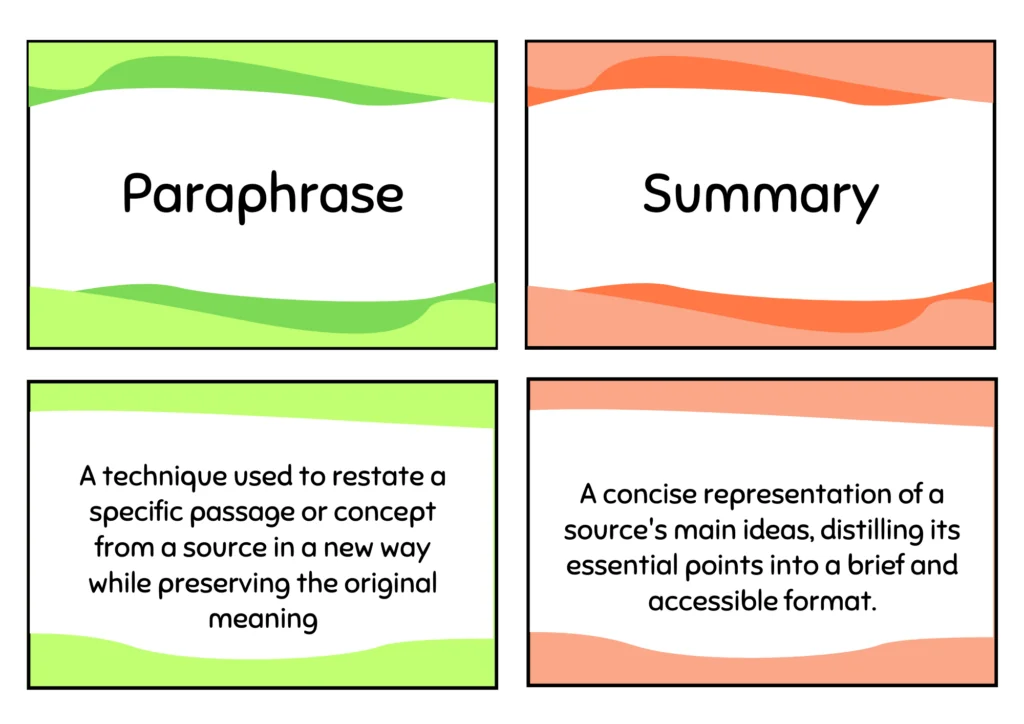In academic writing and everyday communication, effectively conveying information is crucial. Two common techniques for rephrasing original content are paraphrasing and summarizing. While they share the goal of reinterpreting source material, their approaches and purposes differ significantly. This article delves into the nuances of paraphrasing and summarizing, providing clarity on when and how to use each method.

✅ AI Essay Writer ✅ AI Detector ✅ Plagchecker ✅ Paraphraser
✅ Summarizer ✅ Citation Generator
What is a Paraphrase?
Paraphrasing is a technique used to restate a specific passage or concept from a source in a new way while preserving the original meaning. The primary objective of paraphrasing is to make the original content clearer or easier to understand, without changing its underlying message. A successful paraphrase maintains the same length as the original text but employs different vocabulary and sentence structures to express the same idea. This approach ensures that the essence of the original text is communicated effectively, while also demonstrating the writer’s understanding of the material.
For instance, let’s look at a passage from George Orwell’s novel “1984”:
Original: “It was a bright cold day in April, and the clocks were striking thirteen. Winston Smith, his chin nuzzled into his breast in an effort to escape the vile wind, slipped quickly through the glass doors of Victory Mansions, though not quickly enough to prevent a swirl of gritty dust from entering along with him.”
Paraphrase: “On a chilly April day, the clocks struck thirteen as Winston Smith hurried into Victory Mansions to escape the biting wind. Dust swirled around him as he entered through the glass doors, trying to shield his chin from the cold.”
In this paraphrase, the overall structure and length of the original passage are more or less maintained, but different word choices and sentence constructions are used to convey the same scene and actions. This rephrasing allows for a fresh perspective on the text while keeping the original context and meaning intact. We recommend paying attention to the new AI Paraphrasing Tool if you need reliable and high-quality paraphrasing.

What is a Summary?
A summary is a concise representation of a source’s main ideas, distilling its essential points into a brief and accessible format. Unlike a paraphrase, which maintains the original length and detail, a summary is significantly shorter, stripping away extraneous information to focus solely on the core concepts. The structure of a summary typically involves an introduction to the main theme, followed by a streamlined account of the key arguments or events, and concluding with the overarching conclusion or outcome. Summaries are invaluable for providing a quick snapshot of a text, enabling readers to grasp the primary message without engaging with the full details.
For instance, a summary of George Orwell’s novel “1984” might read:
“In George Orwell’s ‘1984,’ the protagonist Winston Smith navigates life in a totalitarian regime where Big Brother controls every aspect of existence, and independent thought is suppressed. The novel explores themes of surveillance, government control, and the erosion of individual freedom. Winston’s struggle against the oppressive government and his doomed romance with Julia highlights the human spirit’s resilience and the dangers of unchecked authority. Ultimately, ‘1984’ serves as a cautionary tale about the potential consequences of totalitarianism and the loss of personal liberties.”
This summary represents the central narrative and themes of “1984” without going deep into the specific plot details or character development found in the full novel.
To understand how to make a proper summary for your academic paper, consider exploring the Free Summarizing Tool, which will provide you with some top-quality summaries.
Contrast & Compare: Paraphrase vs Summary
To deepen our understanding of the distinctions between paraphrasing and summarizing, let us examine another excerpt from George Orwell’s “1984”:
Original: “In the end the Party would announce that two and two made five, and you would have to believe it. It was inevitable that they should make that claim sooner or later: the logic of their position demanded it. Not merely the validity of experience, but the very existence of external reality, was tacitly denied by their philosophy.”
Paraphrase: “Ultimately, the Party would declare that two plus two equals five, and acceptance of this claim would be mandatory. Such an assertion was bound to emerge at some point, as it was a necessary conclusion of their ideology. Their doctrine implied a rejection not just of the significance of personal experience but also of the concept that an external world exists at all.”
Summary: “The Party’s ideology leads to the denial of objective reality, eventually claiming that two plus two equals five, a belief that citizens must accept.”
In this comparison, the paraphrase retains the original passage’s complexity and length, merely altering the phrasing and sentence structure to convey the same ideas with new words. This method allows for a detailed restatement of the original text, preserving its full meaning without directly copying it.
On the other hand, the summary compresses the passage’s key ideas into a concise statement, significantly reducing the length and removing all but the most crucial points. This approach aims to give readers a quick understanding of the primary message without the nuanced detail provided in the original text or the paraphrase.
We presented these examples to illustrate that while a paraphrase is an alternate expression of the same detail and length as the original text, a summary distills the text’s essence into a more compact form. This distinction is essential for effective communication, as it allows the writer to choose the most appropriate method for their purpose—whether to explore an idea in detail or to present a brief overview.
Here are the key points of our comparison, so you can understand and memorize the differences more easily
| Paraphrase | Aspect | Summary |
|---|---|---|
| Similar to original | 📏Length📏 | Much shorter than original |
| Retains most details | 🔍Detail🔍 | Focuses on main points, omits details |
| Clarification, simplification | 🎯Purpose🎯 | Quick overview, gist of content |
| Uses different words and structures | 📋Use of Original✂️ | Condenses original content |
When to Summarize and When to Paraphrase
Deciding whether to summarize or paraphrase depends on the context and objectives of your writing.
Summarizing is particularly useful when dealing with extensive material, and you aim to present the core ideas concisely. For instance, in a literature review, you might summarize various research studies to highlight the overall trends and conclusions without going into the methodology or detailed results of each study. Similarly, in an executive summary, you would distill the key points of a lengthy report or proposal to give decision-makers a quick understanding of the document’s content and significance.
On the other hand, paraphrasing is the better choice when you need to maintain the level of detail in a specific piece of text but present it in a clearer or more relatable way. In a research paper, you might paraphrase a complex theoretical concept to make it more understandable for your audience, while preserving the intricacies of the original idea. Paraphrasing is also useful in analysis, where you need to discuss specific passages of a text in depth, rephrasing them to fit the flow of your argument without oversimplifying or omitting important details.
In short, choose to summarize when you need to condense broad topics into their essential points and opt for paraphrasing when you need to restate detailed information more clearly or differently.
Key Point
Both paraphrasing and summarizing are essential tools in effective communication and writing. Understanding their differences and appropriate applications can enhance your ability to convey information accurately and concisely. While paraphrasing focuses on rewording without losing detail, summarizing aims to capture the essence of the content in a brief form. Choosing the right technique depends on your purpose and the needs of your audience.
FAQ
Follow us on Reddit for more insights and updates.





Comments (0)
Welcome to A*Help comments!
We’re all about debate and discussion at A*Help.
We value the diverse opinions of users, so you may find points of view that you don’t agree with. And that’s cool. However, there are certain things we’re not OK with: attempts to manipulate our data in any way, for example, or the posting of discriminative, offensive, hateful, or disparaging material.